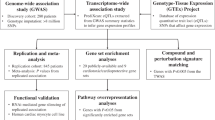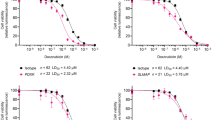Abstract
The intracardiac synthesis of anthracycline alcohol metabolites by aldo–keto reductases (AKRs) contributes to the pathogenesis of anthracycline-related cardiotoxicity. AKR7A2 is the most abundant anthracycline reductase in hearts from donors with and without Down syndrome (DS), and its expression varies between individuals (≈tenfold). We investigated whether DNA methylation impacts AKR7A2 expression in hearts from donors with (n = 11) and without DS (n = 30). Linear models were used to test for associations between methylation status and cardiac AKR7A2 expression. In hearts from donors without DS, DNA methylation status at CpG site −865 correlated with AKR7A2 mRNA (Pearson’s regression coefficient, r = −0.4051, P = 0.0264) and AKR7A2 protein expression (r = −0.5818, P = 0.0071). In heart tissue from donors with DS, DNA methylation status at CpG site −232 correlated with AKR7A2 protein expression (r = 0.8659, P = 0.0025). Multiple linear regression modeling revealed that methylation at several CpG sites is associated with the synthesis of cardiotoxic daunorubicinol. AKR7A2 methylation status in lymphoblastoid cell lines from donors with and without DS was examined to explore potential parallelisms between cardiac tissue and lymphoid cells. These results suggest that DNA methylation impacts AKR7A2 expression and the synthesis of cardiotoxic daunorubicinol.




Similar content being viewed by others
References
Smith, L. A., Cornelius, V. R., Plummer, C. J., Levitt, G., Verrill, M., Canney, P., & Jones, A. (2010). Cardiotoxicity of anthracycline agents for the treatment of cancer: Systematic review and meta-analysis of randomised controlled trials. BMC Cancer, 10, 337.
Krischer, J. P., Epstein, S., Cuthbertson, D. D., Goorin, A. M., Epstein, M. L., & Lipshultz, S. E. (1997). Clinical cardiotoxicity following anthracycline treatment for childhood cancer: The Pediatric Oncology Group experience. Journal of Clinical Oncology, 15, 1544–1552.
O’Brien, M. M., Taub, J. W., Chang, M. N., Massey, G. V., Stine, K. C., Raimondi, S. C., et al. (2008). Cardiomyopathy in children with Down syndrome treated for acute myeloid leukemia: A report from the Children’s Oncology Group Study POG 9421. Journal of Clinical Oncology, 26, 414–420.
Kalabus, J. L., Sanborn, C. C., Jamil, R. G., Cheng, Q., & Blanco, J. G. (2010). Expression of the anthracycline-metabolizing enzyme carbonyl reductase 1 in hearts from donors with Down syndrome. Drug Metabolism and Disposition, 38, 2096–2099.
Minotti, G., Menna, P., Salvatorelli, E., Cairo, G., & Gianni, L. (2004). Anthracyclines: Molecular advances and pharmacologic developments in antitumor activity and cardiotoxicity. Pharmacological Reviews, 56, 185–229.
Olson, R. D., Mushlin, P. S., Brenner, D. E., Fleischer, S., Cusack, B. J., Chang, B. K., & Boucek, R. J, Jr. (1988). Doxorubicin cardiotoxicity may be caused by its metabolite, doxorubicinol. Proceedings of the National Academy of Sciences, 85, 3585–3589.
Minotti, G., Recalcati, S., Mordente, A., Liberi, G., Calafiore, A. M., Mancuso, C., et al. (1998). The secondary alcohol metabolite of doxorubicin irreversibly inactivates aconitase/iron regulatory protein-1 in cytosolic fractions from human myocardium. Faseb Journal, 12, 541–552.
Quinones-Lombrana, A., Ferguson, D., Blair, R. H., Kalabus, J. L., Redzematovic, A., Blanco, J. G. (2014). Interindividual variability in the cardiac expression of anthracycline reductases in donors with and without down syndrome. Pharmaceutical Research, 31, 1644–1655.
Ivanov, M., Kacevska, M., & Ingelman-Sundberg, M. (2012). Epigenomics and interindividual differences in drug response. Clinical Pharmacology and Therapeutics, 92, 727–736.
Cubitt, H. E., Yeo, K. R., Howgate, E. M., Rostami-Hodjegan, A., & Barter, Z. E. (2011). Sources of interindividual variability in IVIVE of clearance: An investigation into the prediction of benzodiazepine clearance using a mechanistic population-based pharmacokinetic model. Xenobiotica, 41, 623–638.
Rostami-Hodjegan, A., & Tucker, G. T. (2007). Simulation and prediction of in vivo drug metabolism in human populations from in vitro data. Nature Reviews Drug Discovery, 6, 140–148.
Ahmed, N. K. (1985). Daunorubicin reductase activity in human normal lymphocytes, myeloblasts and leukemic cell lines. European Journal of Cancer & Clinical Oncology, 21, 1209–1213.
Bogason, A., Masquelier, M., Lafolie, P., Skogastierna, C., Paul, C., Gruber, A., & Vitols, S. (2010). Daunorubicin metabolism in leukemic cells isolated from patients with acute myeloid leukemia. Drug Metabolism Letters, 4, 228–232.
Barron-Vivanco, B. S., Rothenberg, S. J., Medina-Diaz, I. M., Robledo-Marenco, L., Rojas-Garcia, A. E., Hernandez-Cadena, L., et al. (2013). AKRs expression in peripheral blood lymphocytes from smokers: The role of body mass index. Human and Experimental Toxicology, 32, 418–426.
Lemieux, N., Malfoy, B., & Forrest, G. L. (1993). Human carbonyl reductase (CBR) localized to band 21q22.1 by high-resolution fluorescence in situ hybridization displays gene dosage effects in trisomy 21 cells. Genomics, 15, 169–172.
Hefti, E., Quinones-Lombrana, A., Redzematovic, A., Hui, J., Blanco, J. G. (2014). Analysis of mtDNA, miR-155 and BACH1 expression in hearts from donors with and without Down syndrome. Mitochondrial DNA, 1–8.
Gonzalez-Covarrubias, V., Zhang, J., Kalabus, J. L., Relling, M. V., & Blanco, J. G. (2009). Pharmacogenetics of human carbonyl reductase 1 (CBR1) in livers from black and white donors. Drug Metabolism and Disposition, 37, 400–407.
Bustin, S. A., Benes, V., Garson, J. A., Hellemans, J., Huggett, J., Kubista, M., et al. (2009). The MIQE guidelines: Minimum information for publication of quantitative real-time PCR experiments. Clinical Chemistry, 55, 611–622.
Darzynkiewicz, Z., Juan, G. (2001). DNA content measurement for DNA ploidy and cell cycle analysis. Current protocols in cytometry/editorial board. J. Paul Robinson et al. (Eds) 7: 7–5.
McCullagh, P., & Nelder, J. A. N. (1989). Generalized linear models. London: Chapman and Hall.
Farre, D., Roset, R., Huerta, M., Adsuara, J. E., Rosello, L., Alba, M. M., & Messeguer, X. (2003). Identification of patterns in biological sequences at the ALGGEN server: PROMO and MALGEN. Nucleic Acids Research, 31, 3651–3653.
Heinemeyer, T., Wingender, E., Reuter, I., Hermjakob, H., Kel, A. E., Kel, O. V., et al. (1998). Databases on transcriptional regulation: TRANSFAC, TRRD and COMPEL. Nucleic Acids Research, 26, 362–367.
Miranda, T. B., & Jones, P. A. (2007). DNA methylation: The nuts and bolts of repression. Journal of Cellular Physiology, 213, 384–390.
Kacevska, M., Ivanov, M., Wyss, A., Kasela, S., Milani, L., Rane, A., & Ingelman-Sundberg, M. (2012). DNA methylation dynamics in the hepatic CYP3A4 gene promoter. Biochimie, 94, 2338–2344.
Adkins, R. M., Krushkal, J., Tylavsky, F. A., & Thomas, F. (2011). Racial differences in gene-specific DNA methylation levels are present at birth. Birth Defects Research Part A, Clinical and Molecular Teratology, 91, 728–736.
Trevor Hastie, R. T., & Friedman, Jerome. (2009). The elements of statistical learning. Berlin: Springer.
Ressler, K. J., Mercer, K. B., Bradley, B., Jovanovic, T., Mahan, A., Kerley, K., et al. (2011). Post-traumatic stress disorder is associated with PACAP and the PAC1 receptor. Nature, 470, 492–497.
Zhu, X., Li, F., Yang, B., Liang, J., Qin, H., & Xu, J. (2013). Effects of ultraviolet B exposure on DNA methylation in patients with systemic lupus erythematosus. Experimental and Therapeutic Medicine, 5, 1219–1225.
Baron, B. (2012). Breaking the silence: The interplay between transcription factors and DNA methylation, in methylation—From DNA, RNA and histones to diseases and treatment. In A. Dricu (Ed.), p 23, INTECH, Biochemisty, Genetics, and Molecular Biology.
Letourneau, A., Santoni, F. A., Bonilla, X., Sailani, M. R., Gonzalez, D., Kind, J., et al. (2014). Domains of genome-wide gene expression dysregulation in Down’s syndrome. Nature, 508, 345–350.
Pope, B. D., & Gilbert, D. M. (2014). Genetics: Up and down in Down’s syndrome. Nature, 508, 323–324.
Heisey, D. M., & Hoenig, J. M. (2001). The abuse of power: The Pervasive fallacy of power calculations for data analysis. The American Statistician, 55, 19–24.
Grenier, M. A., & Lipshultz, S. E. (1998). Epidemiology of anthracycline cardiotoxicity in children and adults. Seminars in Oncology, 25, 72–85.
Lipshultz, S. E., Sambatakos, P., Maguire, M., Karnik, R., Ross, S. W., Franco, V. I., & Miller, T. L. (2014). Cardiotoxicity and cardioprotection in childhood cancer. Acta Haematologica, 132, 391–399.
Trachtenberg, B. H., Landy, D. C., Franco, V. I., Henkel, J. M., Pearson, E. J., Miller, T. L., & Lipshultz, S. E. (2011). Anthracycline-associated cardiotoxicity in survivors of childhood cancer. Pediatric Cardiology, 32, 342–353.
Lavelle, D., DeSimone, J., Hankewych, M., Kousnetzova, T., & Chen, Y. H. (2003). Decitabine induces cell cycle arrest at the G1 phase via p21(WAF1) and the G2/M phase via the p38 MAP kinase pathway. Leukemia Research, 27, 999–1007.
Tao, J., Liu, Q., Wu, X., Xu, X., Zhang, Y., Wang, Q., & Luo, C. (2013). Identification of hypermethylation in hepatocyte cell adhesion molecule gene promoter region in bladder carcinoma. International Journal of Medical Sciences, 10, 1860–1867.
Lipshultz, S. E., Karnik, R., Sambatakos, P., Franco, V. I., Ross, S. W., & Miller, T. L. (2014). Anthracycline-related cardiotoxicity in childhood cancer survivors. Current Opinion in Cardiology, 29, 103–112.
Deng, S., & Wojnowski, L. (2007). Genotyping the risk of anthracycline-induced cardiotoxicity. Cardiovascular Toxicology, 7, 129–134.
Visscher, H., Ross, C. J., Rassekh, S. R., Barhdadi, A., Dube, M. P., Al-Saloos, H., et al. (2012). Pharmacogenomic prediction of anthracycline-induced cardiotoxicity in children. Journal of Clinical Oncology, 30, 1422–1428.
Lubieniecka, J. M., Graham, J., Heffner, D., Mottus, R., Reid, R., Hogge, D., et al. (2013). A discovery study of daunorubicin induced cardiotoxicity in a sample of acute myeloid leukemia patients prioritizes P450 oxidoreductase polymorphisms as a potential risk factor. Frontiers in Genetics, 4, 231.
Wang, X., Liu, W., Sun, C. L., Armenian, S. H., Hakonarson, H., Hageman, L., et al. (2014). Hyaluronan synthase 3 variant and anthracycline-related cardiomyopathy: A report from the children’s oncology group. Journal of Clinical Oncology, 32, 647–653.
Acknowledgments
Research in this report was supported by the National Institute of General Medical Sciences and the Eunice Kennedy Shriver National Institute of Child Health and Human Development of the National Institutes of Health under Awards R01GM073646 and R03HD076055. The content is solely the responsibility of the authors and does not necessarily represent the official views of the National Institutes of Health.
Author information
Authors and Affiliations
Corresponding author
Electronic supplementary material
Below is the link to the electronic supplementary material.
Rights and permissions
About this article
Cite this article
Hoefer, C.C., Quiñones-Lombraña, A., Blair, R.H. et al. Role of DNA Methylation on the Expression of the Anthracycline Metabolizing Enzyme AKR7A2 in Human Heart. Cardiovasc Toxicol 16, 182–192 (2016). https://doi.org/10.1007/s12012-015-9327-x
Published:
Issue Date:
DOI: https://doi.org/10.1007/s12012-015-9327-x




